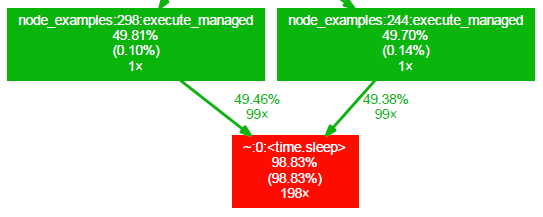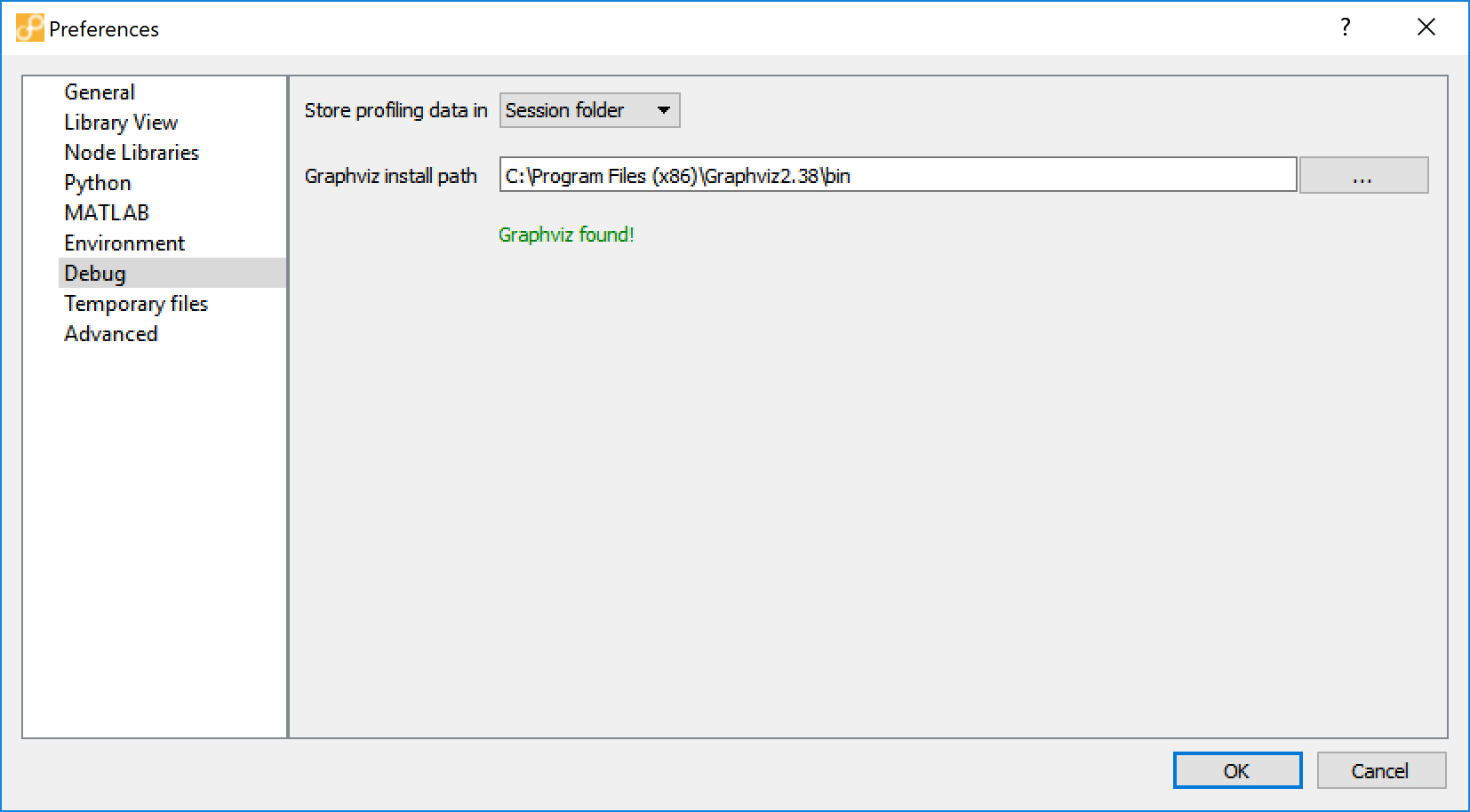Debugging, profiling, and tests¶
Sympathy offers a few tools that will help you fix problems in your nodes, notably interactive debugging and profiling.
Debugging nodes¶
Debugging nodes using Spyder¶
Warning
Since Sympathy 1.6.0, using Spyder for debugging is no longer supported. Please use PyCharm instead, see Debugging nodes using PyCharm.
Debugging nodes using PyCharm¶
PyCharm is an external IDE (not included in Sympathy) which provides good debugging support for Symapthy.
In order to debug Sympathy in PyCharm follow these steps.
- Create a new Project
- Choose the Python interpreter (python.exe) used to run Sympathy as the Project Interpreter. You may have to wait some time for indexing to complete.
- In Settings->Project->Project Structure, add the folders containing the code that you want to debug using Add Content Root. For example, in order to debug anything from Sympathy itself (including the standard library nodes) add <Python>/Lib/site-packages/sympathy_app. Then you may have to wait for another indexing.
- In Run->Edit Configurations, create a new configuration that uses the Project Interpreter. Choose a name that is easy to remember. Set Script: sympathy_app/Sympathy/launch.py, and Script parameters: gui.
- In Run, choose Debug ‘<your-configuration-name>’, this will start Sympathy in debug mode. When debugging you can set breakpoints by clicking on the left margin. When execution in debug mode reaches a breakpoint, it will stop there and allow you to interact with it.
Profiling nodes and workflows¶
If your node or workflow is running too slow you can run the profiler on it to see what parts are taking the most time. If you have configured Graphviz, see Configuring Graphviz, you will also get a call graph.
To profile a single node simply right-click on a node that can be executed and choose Advanced->Profile. This will execute the node and any nodes before it that need to be executed, but only the node for which you chose Profile will be included in the profiling. To profile an entire workflow go to the Controls menu and choose Profile flow. This will execute all nodes in the workflow just as via the Execute flow command. After either execution a report of the profiling is presented in the Messages view. Profiling of single subflows is similar to profiling of single nodes but include all the executable nodes in the subflow.
The profile report consists of a part called Profile report files and a part called Profile report summary.
Profile report files¶
The Profile report files part of the profile report consists of two or four file paths. There is always a path to a txt file and a stats file, and also two pdf files if Graphviz is configured, see Configuring Graphviz. The txt file is a more verbose version of the summary but with full path names and without any limit on the number of rows. The first pdf file contains a visualization of the information in the summary, also called a call graph, and the second a call graph of flows and nodes.
The function call graph contains a node for each function that has been called in the profiled code. The color of the node gives you a hint about how much of the total time was spent inside a specific function. Blue nodes represent functions with low total running time and red nodes represent functions with high total running time. The nodes have the following layout:
First row is the name of the function. Second row is the percentage of the running time spent in this function and all its children. Third row (in parentheses) is the percentage of the running time spent in this function alone. The forth row is the total number of times this function was called (including recursive calls).
The edges of the graph represent the calls between functions and the label at an edge tells you the percentage of the running time transferred from the children to this parent (if available). The second row of the label tells you the number of calls the parent function called the children.
Please note that the total running time of a function has to exceed a certain cut-off to be added to the call graph. So some very fast workflows can produce almost empty call graphs.
A third file will also always be provided with the file ending “.stats”. This file contains all the statistics that was used to create the summary and the call graph. To begin digging through this file open a Python interpreter and write:
>>> import pstats
>>> s = pstats.Stats('/path/to/file.stats')
>>> s.print_stats()
For more information look at the documentation for the Stats class.
Profile report summary¶
The summary contains a row for each function that has been called in the profiled code. Several calls to the same function are gathered into a single row. The first column tells you the number of times a function has been called. The next four columns measure the time that it took to run a specific function. In the last column you can see what function the row is about. See https://docs.python.org/2/library/profile.html for details on how to interpret this table.
The summary also includes up to 10 node names from nodes included in the profiling and an indication of the number of nodes that were ommited to save space.
Configuring Graphviz¶
For the call graph file to be generated Graphviz will have to be installed and the path to the bin folder which contains dot will have to be in either PATH or Graphviz install path in Debug Preferences. Visit http://www.graphviz.org to obtain a copy of Graphviz.
Writing tests for your nodes¶
As with any other code, writing tests for your nodes is a good way of assuring that the nodes work and continue to work as you expect.
Let us start by running the following command from a terminal or command prompt:
python launch.py tests
This will run an extensive test suite on the sympathy platform and on all configured libraries. It tests that the documentation for all nodes can be generated without any errors or warnings and that the configuration GUIs for all nodes can be created. But it does not run the node.
Test workflows¶
The easiest way to test the execution of your nodes is to add them to a workflow (.syx) and put that workflow in <library path>/Test/Workflow/. All workflows in that folder and subfolders are automatically run when running the above command.
In some cases it can be enough to test that the flows can execute without producing exceptions or errors, in other cases, the actual data produced need to be checked. For comparing data, Conditional error/warning and Assert Equal Table may come in handy.
Look in <sympathy folder>/Library/Test/Workflow/ for examples of such test workflows.
Unit tests¶
It is also a good idea to write unit tests to ensure the quality of your
modules. Put unit test scripts in <library path>/Test/Unit/. If the tests are
named correctly they will automatically be found by the Python module nose.
Which is run as a part of launch.py tests. See
https://nose.readthedocs.org/en/latest/finding_tests.html for more details
about how to name your unit tests.
For example a unit test script that tests the two functions foo() and
bar() in the module boblib.bobutils could be called
test_bobutils.py and look something like this:
import numpy as np
from nose.tools import assert_raises
import boblib.bobutils
def test_foo():
"""Test bobutils.foo."""
assert boblib.bobutils.foo(1) == 2
assert boblib.bobutils.foo(0) == None
with assert_raises(ValueError):
boblib.bobutils.foo(-1)
def test_bar():
"""Test bobutils.bar."""
input = np.array([True, False, True])
expected = np.array([False, False, True])
output = boblib.bobutils.bar(input)
assert all(output == expected)
For more examples of real unit tests take a look at the scripts in <sympathy
folder>/Library/Test/Unit/ or have a look at the documentation for the
nose module at https://nose.readthedocs.org/.
You can run only the unit tests of your own library by running the following command from a terminal or command prompt:
python launch.py tests <library path>/Test/Unit


